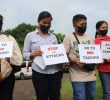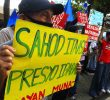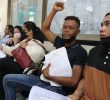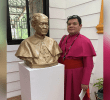The families and the rest of the Muslim people will fight for justice for the slain innocent detainees. They suffered long enough in prison cell for crimes they did not commit.
 COTABATO CITY — Families and friends of the Muslim detainees of Camp Bagong Diwa, as well as the officers and members of Suara Bangsamoro, were so elated when news came out that the Commission on Human Rights has finally released its verdict about the reported summary execution of some Muslim detainees who did not participate in the jailbreak by the Abu Sayyaf Group on March 15, 2006 at Camp Bagong Diwa in Bicutan, Taguig.
COTABATO CITY — Families and friends of the Muslim detainees of Camp Bagong Diwa, as well as the officers and members of Suara Bangsamoro, were so elated when news came out that the Commission on Human Rights has finally released its verdict about the reported summary execution of some Muslim detainees who did not participate in the jailbreak by the Abu Sayyaf Group on March 15, 2006 at Camp Bagong Diwa in Bicutan, Taguig.
This is only the first step for the families of the victims of summary execution. Criminal cases should be immediately filed against former Department of Interior and Local Government (DILG) Secretary Angelo Reyes and Philippine National Police (PNP) director Arturo Lomibao.
With the CHR report in the hands of the DOJ, the burden of determining probable cause is with Secretary Raul Gonzales. However, with the way he is way handling the Subic rape case, Lomibao and Reyes might go scot-free. Judging by the initial reaction of Secretary Gonzales, he will surely squeeze the CHR and the families for the burden of proof.
Because of this, the DILG and the PNP had taken a tough stance and brushed aside the CHR report. Reyes and Lomibao even justified the carnage by saying that the assault in the SICA building in Camp Bagong Diwa where 400 Muslim detainess had been incarcerated was the only way to stop Kosovo and other Abu Sayyaf members who joined the jailbreak.
They even emphasized that those who died at the assault were known Abu Sayyaf leaders such as Alhamser Manatad Limbong alias Commander Kosovo, Nhadzer Abdullah alias Commander Global and Ghalib Andang alias Commander Robot. Reyes and Lomibao could only give three names out of the 22 who died in the carnage.
Reyes is the head of the �crisis management team� tasked by President Gloria Macapagal Arroyo to negotiate with Kosovo and the jailbreakers. If we are to trace back what happened, we would learn that Reyes disregarded the negotiation and pleas of the families of the detainees in favor of police assault. And for this carnage, he was lauded and praised by President Arroyo for handling the jailbreak well.
Based on the initial reports gathered by Karapatan, the Moro-Christian Peoples Alliance and Suara Bangsamoro last year, the Special Action Force of the PNP committed summary executions against some of the Muslim detainees who did not participate in the jailbreak. Out of the six who participated in the jailbreak, only three of them had a .45 caliber gun. How did Commander Kosovo get hold of the gun? This had been one of the issues that raised suspicions among critics that the uprising had the go-signal from other forces. The PNP admitted in news reports last year that based on intelligence reports, Kosovo had in possession a gun as early as December 2004.
Out of the 22, there were six who died but were not part of the jailbreak and not identified as Abu Sayyaf members. They were Ahmad Upao, the oldest detainee suffering from Alzheimer�s disease; Ibnohasser Agasi; Ahmad Arawangsa; Ibrahim Joe Arip; Gaffar Mundi; and Badran Abdulhamid. They were innocent civilians who were victims of a military crackdown ordered by President Gloria Macapagal Arroyo to crush the Abu Sayyaf menace in Basilan, Sulu and Zamboanga on July 13-15, 2001.
Those who survived the carnage at Camp Bagong Diwa were finally able to tell the whole story to their families, doctors who treated their wounds and paralegal groups who visited them days after the carnage. Their stories were published in Bulatlat, an alternative news website, in its April 3-5, 2006 series.
It is true that the SAF had managed to suppress the uprising by killing Kosovo and the rest of his gang. It was a 64-man heavily armed assault team who used a bazooka and teargas to break the defenses of Kosovo’s group who only had a .45 caliber pistol in his hands. Inmates at the first floor of the four-storey SICA building said most of them had locked themselves up in their prison cells because Kosovo was forcing them to join.
An inmate said that when they saw the police, they went to the topmost floor of the SICA building and shouted they were civilians when the SAF elements fired at them. One inmate saw three of his companions already dead — Ahmad Arawangsa, Badran Abdulhamid and Abdulrasid Lim.
According to the inmates, the police team who did the assault ordered all of those who had survived to go up to the topmost floor, clad only in their briefs and were asked one by one who the real ASG were. Those they identified were brought them back to their prison cells and were shot.
This was true in the case of Commander Global, who was a known Abu Sayyaf leader but did not join the jailbreak and whose cell was on the second floor. Reports he was the one talking with one of the members of the “crisis management” to give them a clear view of what’s happening inside the SICA buildiing.
A different story happened with Ghalib Andang, alias Commander Robot. His cell was on the first floor and he could not have joined the jailbreak because he could not walk — both his legs were torn off when the military who arrested him fired several rounds of bullets at his legs. He was found dead in his cell, with a gun in his hand.
Ahmad Opao, a 75-year-old inmate stricken with Alzheimer�s, suffered gunshot wounds. The old man could not have participated in the jailbreak. Because of his disease, human rights organizations and even the doctors who checked on him ordered for his immediate release. The old man did not even know what he was in jail for.
Gaffar Mundi, a high-school student and son of a schoolteacher in Isabela City in Basilan, was also found side by side with the other bodies of those shot during the assault. He was not a member of Abu Sayyaf; his only fault was he was accosted while sleeping in a mosque when the military raided his village during the crackdown in Basilan.
These are the real stories behind the Bicutan siege that were ignored by President Arroyo — hence she praised DILG and PNP for their work. These are the stories that the families of the victims shared to their fellow Muslims — hence the residents of Maharlika Village, where the 22 bodies were buried in a Muslim cemetery there, accorded them a martyr�s burial. These are the stories that the families had told the Commission on Human Rights. A year later, the CHR filed its report and recommended to the DOJ the filing of cases against Lomibao and Reyes.
The families and the rest of the Muslim people will fight for justice for the slain innocent detainees. They suffered long enough in prison cell for crimes they did not commit. Some of those who died, such as Gaffar Mundi, even suffered at the hands of the 103rd Brigade then headed by General Hermogenes Esperon, whose men, during a crackdown in 2001, tortured the detainees and forced them to sign affidavits claiming they were Abu Sayyaf members. Their families have suffered as well.
It�s been almost five years since that crackdown, about 20 have been freed for lack of evidence, six found freedom upon their death because of the siege, two or three also died because of different diseases they got from prison cells in the course of five years. Justice for them is the only the only thing missing in the stories of the victims of crackdown � justice for being falsely accused and justice for being killed in a police assault.
(Amirah Ali Lidasan is the national vice-chairperson of the Suara Bangsamoro Partylist Organization. This is her first column for Davao Today. She can be reached at suarabm@yahoo.com)










